Roger’s Connection
Roger’s Connection is a very nice ‘toy’ made from plastic rods with small magnets embedded in each end, which stick to ball bearings. These rods and balls can be used to make a huge variety of three dimensional, geometric shapes, some of which can support themselves, and some of which can’t…
This page shows some of the shapes we have made with this stuff. Roger’s Connection makes a useful break from the rigors of typing all day (or so we tell ourselves).
There is now a Roger’s Connection web page, from which can order sets, and which has a nice Gallery of constructions by various people.
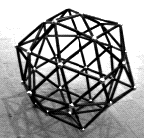
This is a sphere made from pentagons, but, due to the way it rests on the floor, which puts some of the supporting rods under tension, it’s a rather fragile shape. It took a couple of attempts to get the thing together!
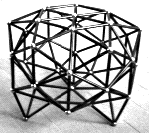
This one looks a lot better in real life — the picture is taken from too high a viewpoint to show the shape well. I suspect that this is actually a squashed bucky ball; anyway, it’s a sort of ovoid shape with legs. Pretty stable, once the structure is complete (and barring the meddling fingers of co-workers).
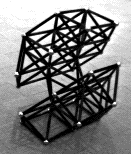
This interesting structure consists of two layers connected by just six struts. Despite this it is remarkably rigid. What’s also nice about it is that you can stand the shape on many of its faces, and it stays up. I like it perched on a small face (as in the picture). Other prefer a more conventional stance on one of the flat surfaces, which brings to mind certain airport buildings.
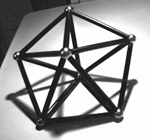
This pentagonal shape is the basis for the structures pictured below. Two or more of these can be connected together in interesting ways, to form more organic-looking shapes.
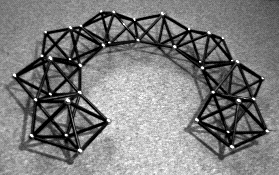
Put 8 of the above pentagonal shapes together, and you get a ring like this, which can flex at each of the joins. Chains of pentagons have a lot of potential to make interesting shapes.
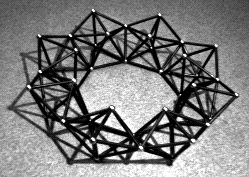
To join up the ends of the ring, simply turn the ring ‘inside out’; push the vertices towards the middle of the ring down, and it turns in on itself, allowing you to join the ends.
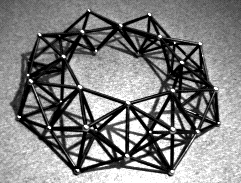
You can also turn the ring the other way (so the center vertices come up), and connect up again. This is simply the above structure turned over.

Here’s an arch made of the same pentagonal shapes. It’s just part of the circle shown above standing on the ends, with some tetrahedral feet added. It’s not very stable either, because of the flex around the joins of the circle.
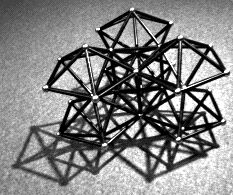
Finally, one of my favourite structures, this is two layers of pentagonal shapes, with three in each layer. The layers are then joined together by allowing the upper and lower points of the pentagons to share a ball, and adding three vertical struts. When complete, it is very rigid. You may think that one could continue building this upwards with many more layers, but no; because the angles are just slightly off, even a third layer is impossible to add.
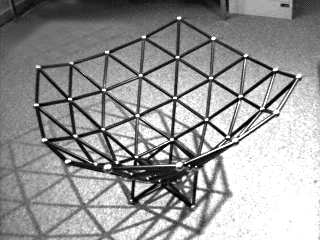
Some quite dramatic bowl shapes can be built, starting from a rigid base and building outwards. This is just the shell of a large, ‘relaxed’ pyramid, upside down of course; it is build on a square base.
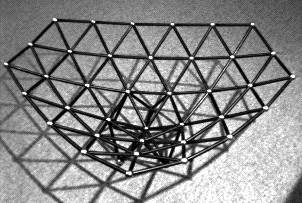
Another variant of the ‘bowl’ type construction. This time, the pentagonal base makes the sides of the bowl less steep. I don’t have enough parts to round off the sides of the bowl any more than this, so settle with a bilaterally symmetrical triangular shape.
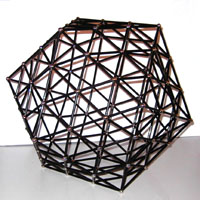
This is my crowning achievement to date, an actual Buckyball, made from 60 balls. Because all the rods are the same length, the pentagonal points stick out a bit, which gives the shape trianglular surfaces (in this configuration, it’s really just a stretched icosahedron). It is extremely hard to build, as the sides tend to fall inwards as you are building them up. I try to avoid this by using rods end-to-end as scaffolding, holding the sides up while building. Even so, it took several attempts to make.
More constructions are available on the Roger’s Connection Gallery page.
permalink | play/rogersconnection | 2007.11.19-22:31.00
